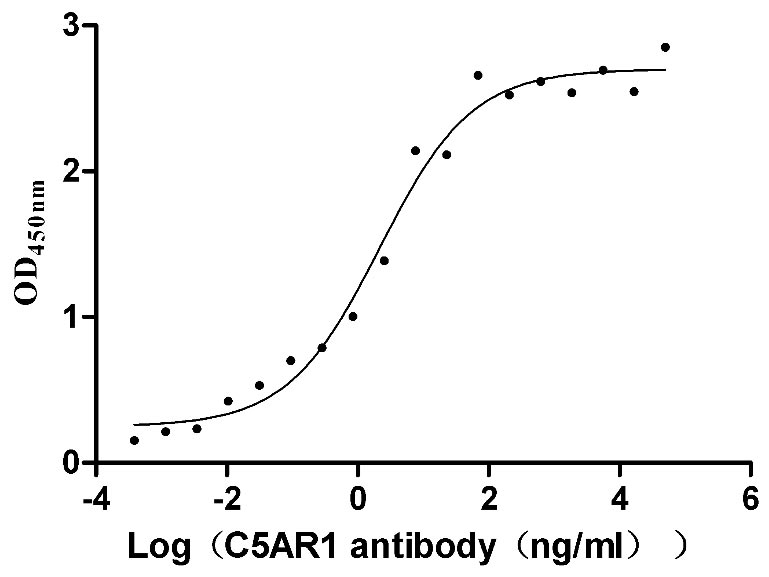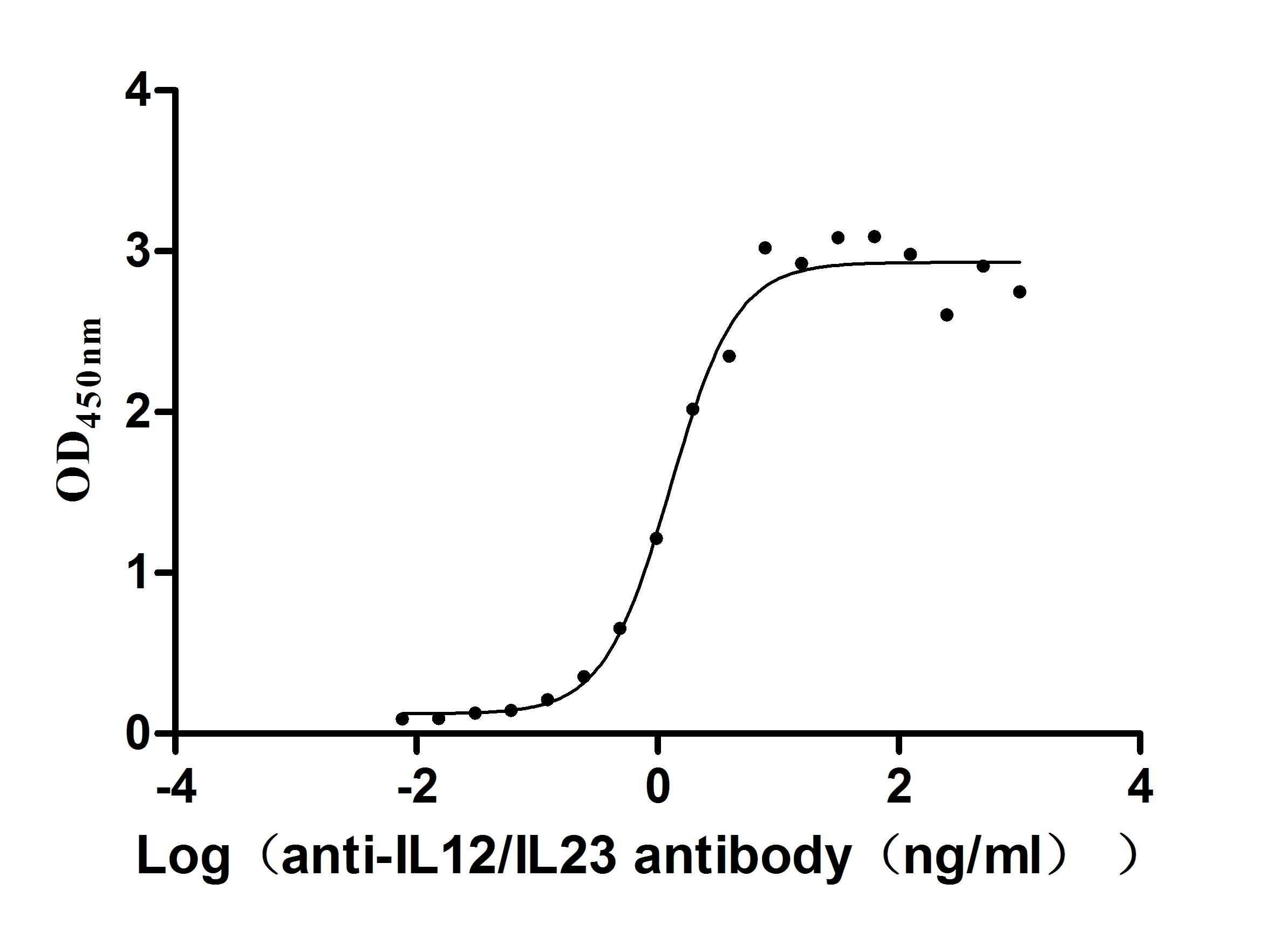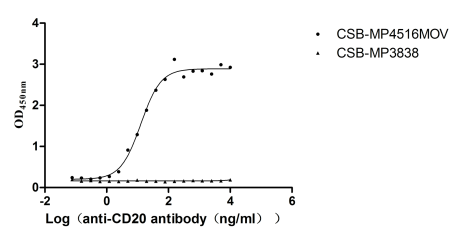Recombinant Human Insulin receptor (INSR)
-
中文名稱:人INSR重組蛋白
-
貨號:CSB-CF011753HU
-
規(guī)格:
-
來源:in vitro E.coli expression system
-
其他:
產(chǎn)品詳情
-
基因名:
-
Uniprot No.:
-
別名:CD220; HHF5; human insulin receptor; Insr; INSR_HUMAN; Insulin receptor subunit beta; IR 1; IR; IR-1 ; IR1
-
種屬:Homo sapiens (Human)
-
蛋白長度:Full Length of Mature Protein
-
表達(dá)區(qū)域:28-758
-
氨基酸序列HLYPGEVCPGMDIRNNLTRLHELENCSVIEGHLQILLMFKTRPEDFRDLSFPKLIMITDYLLLFRVYGLESLKDLFPNLTVIRGSRLFFNYALVIFEMVHLKELGLYNLMNITRGSVRIEKNNELCYLATIDWSRILDSVEDNYIVLNKDDNEECGDICPGTAKGKTNCPATVINGQFVERCWTHSHCQKVCPTICKSHGCTAEGLCCHSECLGNCSQPDDPTKCVACRNFYLDGRCVETCPPPYYHFQDWRCVNFSFCQDLHHKCKNSRRQGCHQYVIHNNKCIPECPSGYTMNSSNLLCTPCLGPCPKVCHLLEGEKTIDSVTSAQELRGCTVINGSLIINIRGGNNLAAELEANLGLIEEISGYLKIRRSYALVSLSFFRKLRLIRGETLEIGNYSFYALDNQNLRQLWDWSKHNLTITQGKLFFHYNPKLCLSEIHKMEEVSGTKGRQERNDIALKTNGDQASCENELLKFSYIRTSFDKILLRWEPYWPPDFRDLLGFMLFYKEAPYQNVTEFDGQDACGSNSWTVVDIDPPLRSNDPKSQNHPGWLMRGLKPWTQYAIFVKTLVTFSDERRTYGAKSDIIYVQTDATNPSVPLDPISVSNSSSQIILKWKPPSDPNGNITHYLVFWERQAEDSELFELDYCLKGLKLPSRTWSPPFESEDSQKHNQSEYEDSAGECCSCPKTDSQILKELEESSFRKTFEDYLHNVVFVPRKTSSGTGAEDPRPSRKRRSLGDVGNVTVAVPTVAAFPNTSS
Note: The complete sequence including tag sequence, target protein sequence and linker sequence could be provided upon request. -
蛋白標(biāo)簽:10xHis-SUMO-tag
-
產(chǎn)品提供形式:Liquid or Lyophilized powder
Note: We will preferentially ship the format that we have in stock, however, if you have any special requirement for the format, please remark your requirement when placing the order, we will prepare according to your demand. -
緩沖液:Lyophilized from Tris/PBS-based buffer, 6% Trehalose, pH 8.0
-
儲存條件:Store at -20°C/-80°C upon receipt, aliquoting is necessary for mutiple use. Avoid repeated freeze-thaw cycles.
-
保質(zhì)期:The shelf life is related to many factors, storage state, buffer ingredients, storage temperature and the stability of the protein itself.
Generally, the shelf life of liquid form is 6 months at -20°C/-80°C. The shelf life of lyophilized form is 12 months at -20°C/-80°C. -
貨期:Basically, we can dispatch the products out in 1-3 working days after receiving your orders. Delivery time may differ from different purchasing way or location, please kindly consult your local distributors for specific delivery time.Note: All of our proteins are default shipped with normal blue ice packs, if you request to ship with dry ice, please communicate with us in advance and extra fees will be charged.
-
注意事項:Repeated freezing and thawing is not recommended. Store working aliquots at 4°C for up to one week.
-
Datasheet & COA:Please contact us to get it.
相關(guān)產(chǎn)品
靶點詳情
-
功能:Receptor tyrosine kinase which mediates the pleiotropic actions of insulin. Binding of insulin leads to phosphorylation of several intracellular substrates, including, insulin receptor substrates (IRS1, 2, 3, 4), SHC, GAB1, CBL and other signaling intermediates. Each of these phosphorylated proteins serve as docking proteins for other signaling proteins that contain Src-homology-2 domains (SH2 domain) that specifically recognize different phosphotyrosine residues, including the p85 regulatory subunit of PI3K and SHP2. Phosphorylation of IRSs proteins lead to the activation of two main signaling pathways: the PI3K-AKT/PKB pathway, which is responsible for most of the metabolic actions of insulin, and the Ras-MAPK pathway, which regulates expression of some genes and cooperates with the PI3K pathway to control cell growth and differentiation. Binding of the SH2 domains of PI3K to phosphotyrosines on IRS1 leads to the activation of PI3K and the generation of phosphatidylinositol-(3, 4, 5)-triphosphate (PIP3), a lipid second messenger, which activates several PIP3-dependent serine/threonine kinases, such as PDPK1 and subsequently AKT/PKB. The net effect of this pathway is to produce a translocation of the glucose transporter SLC2A4/GLUT4 from cytoplasmic vesicles to the cell membrane to facilitate glucose transport. Moreover, upon insulin stimulation, activated AKT/PKB is responsible for: anti-apoptotic effect of insulin by inducing phosphorylation of BAD; regulates the expression of gluconeogenic and lipogenic enzymes by controlling the activity of the winged helix or forkhead (FOX) class of transcription factors. Another pathway regulated by PI3K-AKT/PKB activation is mTORC1 signaling pathway which regulates cell growth and metabolism and integrates signals from insulin. AKT mediates insulin-stimulated protein synthesis by phosphorylating TSC2 thereby activating mTORC1 pathway. The Ras/RAF/MAP2K/MAPK pathway is mainly involved in mediating cell growth, survival and cellular differentiation of insulin. Phosphorylated IRS1 recruits GRB2/SOS complex, which triggers the activation of the Ras/RAF/MAP2K/MAPK pathway. In addition to binding insulin, the insulin receptor can bind insulin-like growth factors (IGFI and IGFII). Isoform Short has a higher affinity for IGFII binding. When present in a hybrid receptor with IGF1R, binds IGF1. PubMed:12138094 shows that hybrid receptors composed of IGF1R and INSR isoform Long are activated with a high affinity by IGF1, with low affinity by IGF2 and not significantly activated by insulin, and that hybrid receptors composed of IGF1R and INSR isoform Short are activated by IGF1, IGF2 and insulin. In contrast, PubMed:16831875 shows that hybrid receptors composed of IGF1R and INSR isoform Long and hybrid receptors composed of IGF1R and INSR isoform Short have similar binding characteristics, both bind IGF1 and have a low affinity for insulin. In adipocytes, inhibits lipolysis.
-
基因功能參考文獻(xiàn):
- The structural refinement of the antagonist once conjugated to insulin provided a set of partial agonists exhibiting between 25 and 70% of the maximal agonism of native insulin at the two insulin receptor isoforms, with only slight differences in inherent potency PMID: 29412818
- Cav-2beta isoform yielded by alternative translation initiation desensitizes insulin receptor (IR) via dephosphorylation by PTP1B, and subsequent endocytosis and lysosomal degradation of IR, causing insulin resistance. PMID: 29604334
- They retained the main IGF-1R-related properties, but the hormones with His49 in IGF-1 and His48 in IGF-2 showed significantly higher affinities for IR-A and for IR-B, being the strongest IGF-1- and IGF-2-like binders of these receptors ever reported. PMID: 29608283
- MARCH1 ubiquitinates INSR to decrease cell surface INSR levels, but unlike other INSR ubiquitin ligases, MARCH1 acts in the basal state rather than after insulin stimulation. PMID: 27577745
- we aim to provide an overview of the physiological and pathophysiological roles of the IR within metabolic syndrome and its related pathologies, including cardiovascular health, gut microflora composition, gastrointestinal tract functioning, polycystic ovarian syndrome, pancreatic cancer, and neurodegenerative disorders PMID: 29462993
- In vitro results show that glycation of INSR decreases insulin binding under hyperglycemic conditions suggesting this mechanism may provide a mechanism by which INS resistance develops in diabetes. PMID: 29207492
- Circulating pri-miRNA-944 and 3662 can improve non-invasive non-small cell lung cancer detection of operable stages of SCC and AC PMID: 28964576
- current data demonstrate that both INSR and IGF1R are directly targeted by C-myc and exert similar effects to promote the tumorigenesis and metastasis of TSCC through the NF-kappaB pathway. PMID: 29518496
- the mechanism by which insulin induces IR translocation to the cell nucleus, was examined. PMID: 29317261
- We conclude that the crosstalk between angiotensin AT1 receptor and insulin receptor signaling shows a high degree of specificity, and involves Galphaq protein, and activation of distinct kinases. Thus, the BRET(2) technique can be used as a platform for studying molecular mechanisms of crosstalk between insulin receptor and 7TM receptors. PMID: 28854843
- INSR rs1051690 SNP is associated with increased risk of gastric cancer, while polymorphisms in IL12B, CCND1 and IL10 genes are not linked with the presence of gastric cancer PMID: 28596683
- Findings demonstrate that, in human breast cancer cells, DDR1 regulates IR expression and ligand dependent biological actions. This novel functional crosstalk is likely clinically relevant. PMID: 28591735
- in beta cells, INSR-B has a protective role, while INSR-A expression sensitizes beta cells to programmed cell death. PMID: 27526875
- These results support the hypothesis that INSR gene expression in different areas of Alzheimer's patient's brains. PMID: 28164769
- In endocrine-sensitive breast cancer cells, insulin was not growth stimulatory, likely due to the presence of hybrid InsR/IGF1R, which has high affinity for IGF-I, but not insulin. Combination inhibition of InsR and IGF1R showed complete suppression of the system in endocrine-sensitive breast cancer cells PMID: 28468775
- Report complex relationships between individual tumor-specific expression of IGF1R/pIGF1R and InsR/pInsR, response endocrine treatment and breast cancer prognosis. PMID: 28030849
- analysis of compounds that cause IGF-1Rbeta but not Insulin Receptor degradation specifically in tumor cells with no effects seen in normal diploid fibroblasts PMID: 27384680
- The gained results are observed not only the unbinding mechanism of IRK-PTP1B complexes came from pulling force profile, number of hydrogen bonds, and interaction energy between IRK and PTP1Bs but also described PTP1B's point mutations could variably change its binding affinity towards IRK. PMID: 28707052
- The data in this paper demonstrate that IR knockdown in primary tumors partially reverses the growth-promoting effects of hyperinsulinemia as well as highlighting the importance of the insulin receptor signaling pathway in cancer progression, and more specifically in epithelial-mesenchymal transition. PMID: 27435064
- INSR rs2252673 and rs3745546 polymorphisms were associated with sensitivity to platinum-based chemotherapy in epithelial ovarian cancer patients and rs2252673 polymorphism may be an independent risk factor for EOC prognosis. PMID: 28436941
- The IGF1R purified in n-dodecyl-beta-D-maltoside showed ligand-stimulated autophosphorylation and kinase activity, suggesting an intact transmembrane signaling mechanism. PMID: 28830678
- Signaling via the insulin (INS) and insulin-like growth factor 1 (IGF1) receptors (INSR and IGF1R) regulate basal cell (BC) differentiation into ciliated cells. PMID: 28050756
- High INSR expression is associated with drug Resistance in Gastrointestinal Stromal Tumors. PMID: 28760855
- the above data indicate a direct role for IR expression as a determinant of PT-gluconeogenesis. Thus reduced insulin signaling of the proximal tubule may contribute to hyperglycemia in the metabolic syndrome via elevated gluconeogenesis. PMID: 27322100
- Activation of D4 receptor inhibits insulin receptor expression in RPT cells from WKY rats. The aberrant inhibition of D4 receptor on insulin receptor expression and effect might be involved in the pathogenesis of essential hypertension. PMID: 27107134
- The HIR MAb binds the insulin receptor on the BBB. PMID: 28279069
- data indicate that post-receptor signalling abnormalities might contribute to Myotonic dystrophy insulin resistance regardless the alteration of INSR splicing. PMID: 28915272
- We identified vascular INSR expression as a potential biomarker for progression in bladder cancer. The data suggest that IGF-2/INSR mediated paracrine crosstalk between bladder cancer cells and endothelial cells is functionally involved in tumour angiogenesis and may thus represent a new therapeutic target. PMID: 28295307
- The INSR rs2059806 SNP is associated with pre-eclampsia phenotypes in two independent cohorts suggesting that genetic susceptibility may be implicated in the link between pre-eclampsia and subsequent vascular and metabolic diseases. PMID: 28117222
- IGF2 and insulin receptor A are important for uterine leiomyoma stem cell proliferation and may represent paracrine signaling between leiomyoma cell types. PMID: 28324020
- Disruption of insulin receptor function inhibits proliferation in endocrine-resistant breast cancer cells PMID: 26876199
- Differential IR isoform expression suggests a distinct role for each in endometrial physiology and cancer. PMID: 27088794
- Results show that IR expression level in renal cell carcinoma tissue was significantly lower in patients with tumor stage pT2-4 and/or distant metastases. PMID: 28393204
- Findings suggest that the induction of microRNA miR-1271 by saturated fatty acid palmitate promotes the development of insulin resistance by targeting insulin receptor (INSR) and insulin receptor substrate 1 protein (IRS-1) in hepatocytes. PMID: 27613089
- Study reveals an important function of CHIP-mediated proteolysis in insulin and IGF1 signaling; upon proteotoxic stress conditions and during aging, CHIP is recruited toward disposal of misfolded proteins, reducing its capacity to degrade the INSR; identify a degradation pathway that controls the level of active DAF-2/INSR in C. elegans, Drosophila and human cells. PMID: 28431247
- EGF and insulin receptor tyrosine kinase exemplify how receptor location is coupled to signal transduction. (Review) PMID: 27023845
- a straightforward protocol for production of recombinant IGF-II and prepared six IGF-II analogs with IGF-I-like mutations. All modified molecules exhibit significantly reduced affinity toward IR-A, particularly the analogs with a Pro-Gln insertion in the C-domain. Moreover, one of the analogs has enhanced binding affinity for IGF-1R due to a synergistic effect of the Pro-Gln insertion and S29N point mutation. PMID: 27510031
- Conus geographus G1 (Con-Ins G1), is the smallest known insulin found in nature and lacks the C-terminal segment of the B chain that, in human insulin, mediates engagement of the insulin receptor and assembly of the hormone's hexameric storage form. This study found that Con-Ins G1 is monomeric, strongly binds the human insulin receptor and activates receptor signaling. PMID: 27617429
- Mutations of the INSR gene is associated with acanthosis nigricans and hyperandrogenism. PMID: 27505086
- Identification of a Novel Homozygous INSR Variant in a Patient with Rabson-Mendenhall Syndrome from the United Arab Emirates. PMID: 27326825
- Findings suggest that insulin receptor substrate -1 Gly972Arg polymorphism is associated with polycystic ovary syndrome in the Caucasian ethnicity, and insulin receptor substrate -2 Gly1057Asp polymorphism is correlated with polycystic ovary syndrome in the Asian ethnicity. However, insulin receptor His 1058 C/T polymorphism may not be implicated in polycystic ovary syndrome. PMID: 27098445
- Two miR-binding SNPs SLC30A8 rs2466293 and INSR rs1366600 increased Gestational diabetes mellitus susceptibility. Functional studies were required to confirm the underlying mechanism. PMID: 28190110
- The data demonstrate that insulin, IGF1 and IGF2 elicit different insulin receptor phosphorylation kinetics and potencies that translate to downstream signaling. PMID: 27155325
- Suggest a novel role of miR-503 as a regulator of vascular smooth muscle cell proliferation and migration by modulating INSR. PMID: 27829550
- In silico characterization of nsSNPs affecting INSR gene function can aid in better understanding of genetic differences in disease susceptibility. PMID: 27840822
- The INSR gene is potentially associated with eating difficulties in preterm infants. PMID: 26629831
- four compounds demonstrated considerably increased binding affinity towards IR and less toxicity compared with parent compounds. Finally, molecular interaction analysis revealed that six parent compounds and four analogues interact with the active site amino acids of IR PMID: 27034931
- Study describes a revised structure of the human insulin receptor ectodomain revealing new features within the receptor insert domain and corrects errors in the first and third fibronectin type III domains. The new structure allows improved resolution of the insert domain, a critical element to ligand binding and signal transduction. PMID: 26853939
- C1008T SNP at exon 17 of INSR is associated with insulin resistance in Indian women with polycystic ovarian syndrome. PMID: 26721804
- A novel insertion/deletion (indel) mutation was found in INSR gene. PMID: 26874853
顯示更多
收起更多
-
相關(guān)疾病:Rabson-Mendenhall syndrome (RMS); Leprechaunism (LEPRCH); Diabetes mellitus, non-insulin-dependent (NIDDM); Familial hyperinsulinemic hypoglycemia 5 (HHF5); Insulin-resistant diabetes mellitus with acanthosis nigricans type A (IRAN type A)
-
亞細(xì)胞定位:Cell membrane; Single-pass type I membrane protein. Late endosome. Lysosome.
-
蛋白家族:Protein kinase superfamily, Tyr protein kinase family, Insulin receptor subfamily
-
組織特異性:Isoform Long and isoform Short are predominantly expressed in tissue targets of insulin metabolic effects: liver, adipose tissue and skeletal muscle but are also expressed in the peripheral nerve, kidney, pulmonary alveoli, pancreatic acini, placenta vasc
-
數(shù)據(jù)庫鏈接:
Most popular with customers
-
Recombinant Human Tumor necrosis factor ligand superfamily member 13B (TNFSF13B), partial (Active)
Express system: Mammalian cell
Species: Homo sapiens (Human)
-
Recombinant Human Poliovirus receptor (PVR) (I340M), partial (Active)
Express system: Mammalian cell
Species: Homo sapiens (Human)
-
Recombinant Macaca mulatta Microtubule-associated protein tau (MAPT) (Active)
Express system: Mammalian cell
Species: Macaca mulatta (Rhesus macaque)
-
Recombinant Human C5a anaphylatoxin chemotactic receptor 1 (C5AR1)-VLPs (Active)
Express system: Mammalian cell
Species: Homo sapiens (Human)
-
Recombinant Human IL12B&IL12A Heterodimer Protein (Active)
Express system: Mammalian cell
Species: Homo sapiens (Human)
-
Recombinant Macaca fascicularis Membrane spanning 4-domains A1 (MS4A1)-VLPs (Active)
Express system: Mammalian cell
Species: Macaca fascicularis (Crab-eating macaque) (Cynomolgus monkey)
-
Recombinant Human Myosin regulatory light polypeptide 9 (MYL9) (Active)
Express system: Yeast
Species: Homo sapiens (Human)
-
Recombinant Human CUB domain-containing protein 1 (CDCP1), partial (Active)
Express system: Mammalian cell
Species: Homo sapiens (Human)



-AC1.jpg)
















